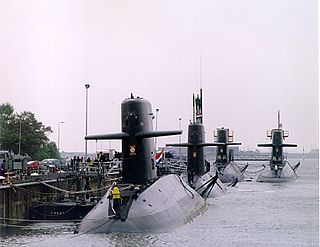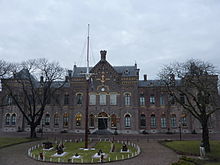
The Netherlands Armed Forces are the military forces of the Kingdom of the Netherlands. The armed forces consist of four service branches: the Royal Netherlands Navy, the Royal Netherlands Army, the Royal Netherlands Air Force and the Royal Netherlands Marechaussee. The service branches are supplemented by various joint support organizations. In addition, local conscript forces exist on the Dutch Caribbean islands of Aruba and Curaçao. These operate under the auspices of the Royal Netherlands Navy and the Netherlands Marine Corps. The armed forces are part of the Ministry of Defence.
The Royal Netherlands Navy is the maritime service branch of the Netherlands Armed Forces. It was founded on 8 January 1488, making it the third-oldest naval force in the world.

The Netherlands Marine Corps is the elite naval infantry corps of the Royal Netherlands Navy, one of the four Armed Forces of the Kingdom of the Netherlands. The marines trace their origins to the establishment of the Regiment de Marine on 10 December 1665, by the then grand pensionary of the Dutch Republic, Johan de Witt and famous Admiral Michiel de Ruyter. It is the second-oldest still-active marine corps in the world.

The Military William Order, or often named Military Order of William, is the oldest and highest honour of the Kingdom of the Netherlands. It is named after St. William of Gellone (755–814), the first Prince of Orange. Its motto is Voor Moed, Beleid en Trouw. The chivalric order was established on 30 April 1815 by King William I and was presented for feats of excellent bravery on the battlefield and as a meritorious decoration to senior military officers. Comparable with the French Légion d’Honneur but far less often awarded, it is open to everyone regardless of rank or nobility—not only to Dutch military, but also to foreigners. To date, membership in the Order is extremely rarely awarded, and only for exceptional bravery in battle.

The Royal Netherlands Army is the land branch of the Netherlands Armed Forces. Though the Royal Netherlands Army was raised on 9 January 1814, its origins date back to 1572, when the Staatse Leger was raised making the Dutch standing army one of the oldest in the world. It fought in the Napoleonic Wars, World War II, the Indonesian War of Independence and the Korean War, as well as served with NATO on the Cold War frontiers in West Germany from the 1950s to the 1990s.

The Walrus-class submarine is the only submarine class currently in operation in the Royal Netherlands Navy. The boats have been in service since 1990 and are all named after sea mammals.

The Royal Military Academy is the service academy for the Dutch Army, the Dutch Air Force and the Royal Marechaussee. Located in Breda, Southern Netherlands, the KMA has trained future officers since 1828.

Willem Johan Cornelis, Ridder Huijssen van Kattendijke was a career officer of the Royal Dutch Navy and a politician. As an officer, he reached the rank of Commander. He was Dutch Naval Minister from 1861 to 1866, and interim Dutch Foreign Minister in 1864.

Gerhard Christiaan Coenraad (Gerrit) Pels Rijcken was a career officer of the Royal Dutch Navy and a politician. As an officer, Pels Rijcken reached the rank of Vice-Admiral. He was Dutch Navy Minister from 1866 to 1868.

Major Marinus Johannes "Marco" Kroon, RMWO, is a Dutch officer serving with the Korps Commandotroepen. Kroon is one of only three living knights 4th class of the Military Order of William and the first new member appointed to this Dutch Order in over half a century. The Military William Order is the highest honour in the Netherlands, bestowed for "performing excellent acts of Bravery, Leadership and Loyalty in battle".

Wassila Hachchi is a Dutch former politician and former civil servant and Royal Netherlands Navy officer. As a member of Democrats 66 (D66) she was an MP from 17 June 2010 until 19 January 2016. She focused on matters of defense, development aid and Kingdom relations.

Lieutenant general Robert (Rob) Verkerk is a retired officer of the Netherlands Marine Corps who served as the 4th Commander of the Naval Forces from 26 september 2014 untl his retirement on 22 september 2017. he was succeeded by Rob Kramer

Frits Jan Willem den Ouden was a Dutch bomber pilot during World War II. He flew missions for the Royal Netherlands East Indies Army Air Force from 1936 to 1950, working his way up to the rank of captain.

The Netherlands Maritime Special Operations Forces is the special forces unit of the Marine Corps of the Royal Netherlands Navy. It is one of the three principal units tasked with special operations in the Netherlands. The unit can be deployed worldwide to conduct special operations, including counter-terrorism both overseas and domestically, with a maritime focus. Its operations are planned and coordinated by the Netherlands Special Operations Command.
In April 2018, the Dutch Government approved a multi-year investment program for the Dutch Navy and allocated funds for the 2018–2030 period. The Dutch Defence Materiel Administration (DMO) is in charge of the procurement of these new ships.

HNLMS Den Helder is a new replenishment oiler under construction for the Royal Netherlands Navy. Also known as the Combat Support Ship (CSS), Den Helder is planned to fill the gap of replenishment at sea that was left after HNLMS Amsterdam was sold to Peru in 2014.

Ida Laura Veldhuyzen van Zanten was a Dutch pilot and social worker who was a member of the Dutch resistance during the Second World War and a pilot in the British Air Transport Auxiliary. She was the only woman to receive the Vliegerkruis, the Airman's Cross.

The Rotterdam class are two landing platform dock (LPD) ships in service with the Royal Netherlands Navy. Built by Damen Schelde Naval Shipbuilding at Vlissingen, their mission is to carry out amphibious warfare by transporting the bulk of the Korps Mariniers. These ships have both a large helicopter flight deck and a well deck for large landing craft, as well as space for up to 33 main battle tanks.



















